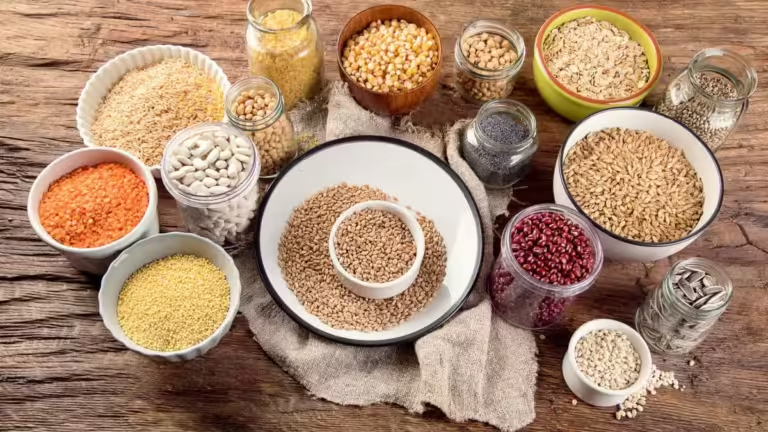Introduction to Ancient Grains
- Brief history and significance
- Types of ancient grains
Nutritional Benefits of Ancient Grains
- High fiber content
- Rich in essential nutrients
- Low glycemic index
Comparison with Modern Grains
- Nutritional differences
- Processing methods
Health Benefits of Including Ancient Grains in Diet
- Heart health
- Weight management
- Digestive health
Cooking with Ancient Grains
- Versatility in recipes
- Cooking tips and techniques
Popular Ancient Grain Recipes
- Quinoa salad
- Amaranth porridge
- Farro risotto
Ancient Grains in Gluten-Free Diets
- Safe alternative for gluten-sensitive individuals
- Celiac disease considerations
Sustainability and Environmental Impact
- Cultivation practices
- Reduced water usage
Challenges in Accessing Ancient Grains
- Availability in mainstream markets
- Cost considerations
Tips for Incorporating Ancient Grains into Daily Routine
- Meal planning strategies
- Budget-friendly options
Ancient Grains in Culinary Traditions
- Historical significance in various cultures
- Modern adaptations
Research and Studies on Ancient Grains
- Scientific evidence supporting health claims
- Areas for further research
Myths and Misconceptions about Ancient Grains
- Addressing common misconceptions
- Debunking myths
Ancient Grains as Superfoods
- Marketing hype vs. reality
- Balanced perspective
Conclusion
- Recap of the benefits
- Encouragement to incorporate ancient grains into diet
Ancient Grain in a healthy Cereals
In today’s fast-paced world, the quest for healthier eating options has led many individuals to explore the wonders of ancient grains. From quinoa to amaranth, these time-honored staples are making a comeback in modern diets, and for good reason. Let’s delve into the rich tapestry of ancient grains, exploring their nutritional benefits, culinary versatility, and the profound impact they can have on our health and well-being.
Introduction to Ancient Grains
A Brief History and Significance
Ancient grains have been cultivated for thousands of years by ancient civilizations such as the Egyptians, Greeks, and Aztecs. These grains, untouched by modern genetic modification, offer a glimpse into our culinary past and provide a connection to our ancestral roots.
Types of Ancient Grains
Ancient grains encompass a diverse range of species, including quinoa, amaranth, farro, spelt, and teff, each with its own unique flavor profile and nutritional composition.
Nutritional Benefits of Ancient Grains
High Fiber Content
Ancient grains are renowned for their high fiber content, which promotes digestive health, regulates blood sugar levels, and aids in weight management.
Rich in Essential Nutrients
Packed with essential vitamins, minerals, and antioxidants, ancient grains provide a nutrient-dense source of sustenance, nourishing the body from within.
Low Glycemic Index
Unlike refined grains, ancient grains have a low glycemic index, meaning they cause a slower and more gradual rise in blood sugar levels, making them an ideal choice for individuals looking to keep up with stable energy levels over the course of the day.
Comparison with Modern Grains
Nutritional Differences
Modern grains, such as wheat and rice, have undergone extensive processing, stripping them of their natural nutrients and fiber content, whereas ancient grains retain their nutritional integrity.
Processing Methods
The minimal processing involved in cultivating and harvesting ancient grains preserves their inherent nutritional value, ensuring that each kernel remains a powerhouse of health benefits.
Health Benefits of Including Ancient Grains in Diet
Heart Health
Studies have shown that incorporating ancient grains into the diet can lower the risk of heart disease by reducing cholesterol levels and improving overall cardiovascular health.
Weight Management
The high fiber content of ancient grains promotes satiety, helping to curb cravings and prevent overeating, making them an excellent choice for individuals looking to maintain a healthy weight.
Digestive Health
The fiber and prebiotics found in ancient grains support a healthy gut microbiome, aiding in digestion and promoting optimal nutrient absorption.
Cooking with Ancient Grains
Versatility in Recipes
From savory pilafs to hearty breakfast bowls, ancient grains lend themselves to a myriad of culinary creations, adding depth and texture to any dish.
Cooking Tips and Techniques
Cooking ancient grains requires a different approach than their modern counterparts, with methods such as soaking and rinsing helping to enhance flavor and texture.
Popular Ancient Grain Recipes
Quinoa Salad
A refreshing medley of quinoa, fresh vegetables, and herbs, tossed in a zesty vinaigrette for a light and nutritious meal.
Amaranth Porridge
A creamy porridge made from amaranth, simmered in coconut milk and topped with sweet berries and nuts for a wholesome breakfast option.
Farro Risotto
A rustic twist on the classic Italian dish, featuring farro cooked to creamy perfection with mushrooms, Parmesan cheese, and fragrant herbs.
Ancient Grains in Gluten-Free Diets
Safe Alternative for Gluten-Sensitive Individuals
Ancient grains such as quinoa and amaranth are naturally gluten-free, making them a safe and nutritious choice for individuals with celiac disease or gluten sensitivity.
Celiac Disease Considerations
While ancient grains are inherently gluten-free, cross-contamination can occur during processing, so it’s essential to source certified gluten-free products for those with severe gluten allergies.
Sustainability and Environmental Impact
Cultivation Practices
Ancient grains are well-adapted to diverse climates and require fewer inputs such as water and pesticides, making them a more sustainable option compared to conventional grains.
Reduced Water Usage
The drought-resistant nature of many ancient grain varieties makes them an environmentally friendly choice in regions prone to water scarcity.
Challenges in Accessing Ancient Grains
Availability in Mainstream Markets
While ancient grains are gaining popularity, they may still be challenging to find in some mainstream supermarkets, requiring consumers to seek out specialty stores or online retailers.
Cost Considerations
The higher price point of ancient grains compared to conventional grains may pose a barrier to accessibility for some individuals, necessitating budget-conscious shopping strategies.
Tips for Incorporating Ancient Grains into Daily Routine
Meal Planning Strategies
Integrating ancient grains into meal plans can be made easier by batch cooking grains in advance and incorporating them into a variety of dishes throughout the week.
Budget-Friendly Options
Opting for less expensive varieties of ancient grains, such as millet or sorghum, can help mitigate costs while still reaping the nutritional benefits.
Ancient Grains in Culinary Traditions
Historical Significance in Various Cultures
Ancient grains have been a staple of diets around the world for millennia, playing a central role in cultural celebrations and culinary traditions.
Modern Adaptations
While traditional recipes endure, modern chefs and home cooks are putting their own spin on ancient grain dishes, incorporating global flavors and innovative cooking techniques.
Research and Studies on Ancient Grains
Scientific Evidence Supporting Health Claims
Numerous studies have documented the health benefits of ancient grains, providing empirical evidence to support their inclusion in a balanced diet.
Areas for Further Research
As interest in ancient grains continues to grow, ongoing research is needed to explore their potential therapeutic applications and optimize cultivation practices for sustainability.
Myths and Misconceptions about Ancient Grains
Addressing Common Misconceptions
Misinformation surrounding ancient grains, such as their purported lack of flavor or difficulty in cooking, can deter individuals from incorporating them into their diets.
Debunking Myths
By dispelling myths and providing practical tips for preparation and cooking, consumers can feel confident in their ability to enjoy the nutritional benefits of ancient grains.
Ancient Grains as Superfoods
Marketing Hype vs. Reality
While ancient grains have garnered attention as superfoods, it’s essential to approach them with a balanced perspective, recognizing their value as part of a diverse and varied diet.
Balanced Perspective
While ancient grains offer numerous health benefits, they are not a cure-all solution and should be enjoyed as part of a well-rounded diet rich in fruits, vegetables, lean proteins, and healthy fats.
Conclusion
In conclusion, ancient grains represent a nutritional treasure trove that is waiting to be rediscovered. From their rich history to their unparalleled health benefits, these ancient staples have stood the test of time and continue to enrich our lives in countless ways. By incorporating ancient grains into our diets, we not only nourish our bodies but also honor the traditions of our ancestors, forging a connection to the past that supports us in the present and shapes our future.
FAQs
Are ancient grains suitable for individuals following a gluten-free diet?
- A: Yes, many ancient grains such as quinoa, amaranth, and teff are naturally gluten-free, making them safe for those with gluten sensitivities or celiac disease.
What is the best way to cook ancient grains for optimal flavor and texture?
- A: To enhance the flavor and texture of ancient grains, it’s recommended to rinse them thoroughly before cooking and to use a ratio of water to grain that ensures a light, fluffy texture.
Are ancient grains more nutritious than modern grains?
- A: Ancient grains tend to be less processed than modern grains, retaining more of their natural nutrients and fiber content, making them a healthier choice overall.
Where can I purchase ancient grains if they’re not available at my local supermarket?
- A: Many health food stores and specialty grocers carry a wide selection of ancient grains, and online retailers offer convenient options for home delivery.
Can ancient grains be included in a weight loss diet?
- A: Yes, ancient grains are a valuable addition to a weight loss diet due to their high fiber content, which promotes feelings of fullness and aids in appetite control.
- Introduction to World Health Day: The Ultimate Guide to Mental Wellness
- Understanding the Meaning of World Health Day: The Ultimate Guide to Mental Wellness
- Exploring the Purpose
- Reflecting Global Health Priorities
- World Health Day Theme 2024: A Brief look into the Eventual fate of Medical care
- Unveiling the Chosen Theme
- Analyzing the Relevance
- Significance of Bringing issues to light through World Wellbeing Day Subjects
- Addressing Health Challenges
- Promoting Preventive Measures
- Significant Ways Of observing World Wellbeing Day 2024
- Community Health Initiatives
- Educational Campaigns
- Engaging in Sustainable Health Practices
- Environmental Health Connection
- Promoting Wellness Culture
- The Job of Innovation in Progressing Worldwide Wellbeing
- Telemedicine and Remote Healthcare
- Innovations in Healthcare Delivery
- Collaborative Efforts Towards Achieving Health Equity
- Addressing Health Disparities
- Ensuring Access to Quality Healthcare
- Conclusion: Embracing the World Wellbeing Day Topic 2024



1 thought on “Uncover the Secret Powers of Ancient Grains: Transform Your Breakfast with Healthy Cereals”